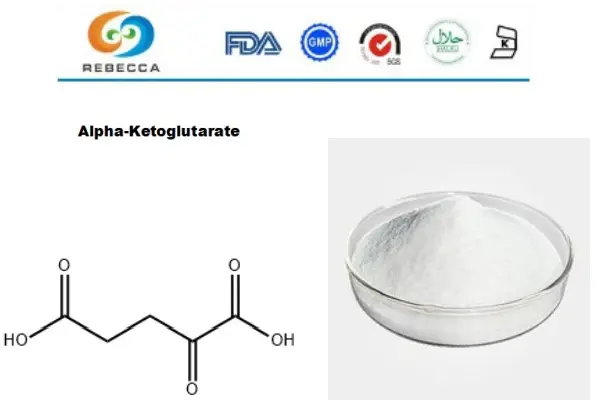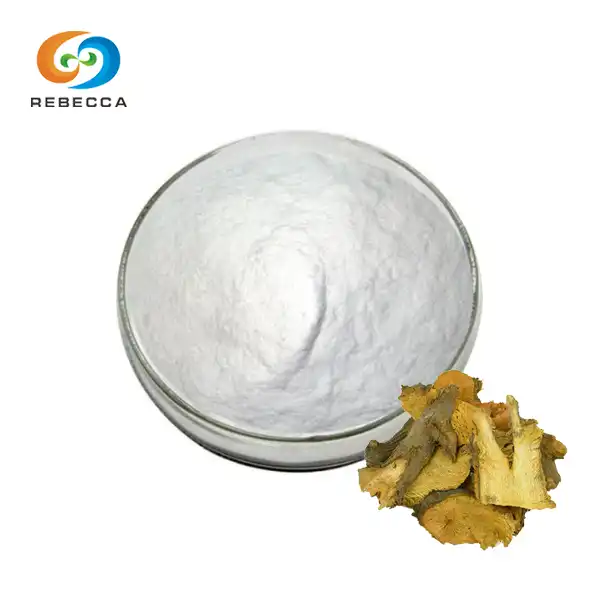What Is Alpha-Ketoglutarate?
Alpha-ketoglutarate powder, also known as -ketoglutarate or AKG, is a crucial molecule in the metabolism of cells that has received a lot of attention in recent years due to its potential health benefits and applications in a variety of fields. This natural build assumes an essential part in a few organic cycles and has turned into a subject of interest for specialists, wellbeing devotees, and the drug business the same. We'll look at this product's chemical structure, biological functions, quality control measures, stability, and commercial availability in this comprehensive guide.

Chemical Structure And Properties
Alpha-ketoglutarate is a five-carbon dicarboxylic acid with the molecular formula C5H6O5. It is a white crystalline powder that is easy to work with in labs and factories because it dissolves quickly in water. The presence of two carboxyl groups and a -keto group (a carbonyl group adjacent to the carbon atom at the end of the molecule) distinguishes the structure of -ketoglutarate. This special course of action of practical gatherings adds to its synthetic reactivity and organic significance.
The molecular weight of α-ketoglutarate is approximately 146.11 g/mol, and its structural formula can be represented as HOOC-CH2-CH2-CO-COOH. The presence of the keto gathering and carboxyl gatherings permits α ketoglutarate to take part in different biochemical responses, including oxidation-decrease cycles and transamination responses. These properties make it a fundamental middle of the road in a few metabolic pathways.
In aqueous solutions, Alpha-ketoglutarate powder exists primarily in its ionized form, with the carboxyl groups dissociated to form carboxylate anions. This ionic nature contributes to its high solubility in water and its ability to form salts with various cations. The compound's pKa values (the negative logarithm of the acid dissociation constant) are approximately 2.47 and 4.68 for the two carboxyl groups, indicating its behavior as a moderately strong acid in solution.

Biological Function
Alpha-ketoglutarate assumes a focal part in cell digestion, especially as a vital transitional in the Krebs cycle (TCA cycle), otherwise called the Krebs cycle or citrus extract cycle. This repetitive cycle is central to oxygen consuming breath, where cells create energy as ATP (adenosine triphosphate) through the oxidation of acetyl-CoA got from starches, fats, and proteins.
In the TCA cycle, α-ketoglutarate is formed from isocitrate through oxidative decarboxylation, catalyzed by the enzyme isocitrate dehydrogenase. It then undergoes further oxidative decarboxylation to form succinyl-CoA, a reaction catalyzed by the α ketoglutarate dehydrogenase complex. This step is crucial for the continuation of the cycle and the generation of reducing equivalents (NADH and FADH2) that are used in the electron transport chain for ATP production.
Beyond its role in energy metabolism, α-ketoglutarate is intricately involved in amino acid metabolism. It serves as a critical link between carbohydrate and protein metabolism, participating in transamination reactions that facilitate the interconversion of amino acids. For instance, α-ketoglutarate acts as an amino group acceptor in reactions catalyzed by aminotransferases, leading to the formation of glutamate. Because this process can be reversed, glutamate can donate its amino group to other -keto acids, resulting in the formation of new amino acids and the regeneration of -ketoglutarate.
Besides, α ketoglutarate is a forerunner for the blend of glutamate and, likewise, glutamine. Glutamate is an essential amino acid in many physiological processes, including protein synthesis and acid-base equilibrium, in the central nervous system. Glutamate is likewise a fundamental synapse. The body's nitrogen digestion and smelling salts detoxification are fundamentally affected by the interconversion of - ketoglutarate, glutamate, and glutamine. The role of -ketoglutarate in cellular senescence and epigenetic regulation has also been highlighted in recent research. The alpha-ketoglutarate powder is a co-substrate for dioxygenase catalysts, including those involved in DNA and histone demethylation. Examines into its possible role in maturing cycles and age-related diseases have been prompted by this association with epigenetic changes.

Quality Control
Ensuring the quality and purity of α-ketoglutarate is crucial, especially for its use as an active pharmaceutical ingredient (API) or in dietary supplements. The quality control process for API-grade α ketoglutarate typically involves a series of rigorous tests and analyses to verify its identity, purity, and safety.
- The primary component of quality control is content determination, which is typically carried out with high-performance liquid chromatography (HPLC). This analytical method makes it possible to precisely measure the amount of -ketoglutarate in a sample, ensuring that it satisfies the specified purity standards—typically a minimum of 98 percent or 99%, depending on the grade that is required.
- Debasement investigation is one more basic part of the quality control process. The -ketoglutarate sample's related substances and impurities must be identified and quantified as part of this procedure. Again, HPLC is the preferred method for this analysis because it can detect and measure traces of impurities. Other organic acids or synthesis byproducts are examples of common impurities.
- Weighty metal breaking point testing is fundamental to guarantee the well-being of α-ketoglutarate for human utilization or drug use. Heavy metals like lead, mercury, cadmium, and arsenic can be detected and quantified in trace amounts using methods like atomic absorption spectroscopy (AAS) or inductively coupled plasma mass spectrometry (ICP-MS). These contaminants' acceptable limits are typically established by regulatory bodies and must be strictly adhered to.
- Microbial limit testing is performed to ensure that the α ketoglutarate is free from harmful microorganisms. This involves culturing samples to detect the presence of bacteria, yeasts, and molds. The total aerobic microbial count (TAMC) and total yeast and mold count (TYMC) are determined, and tests for specific pathogens like Escherichia coli, Salmonella, and Staphylococcus aureus are conducted.
- Extra quality control measures might incorporate checks for lingering solvents, which can be available because of the assembling system, and assurance of actual properties like softening point, dissolvability, and pH of watery arrangements. Together, these tests guarantee that the -ketoglutarate satisfies the purity, safety, and consistency requirements.

Stability Study
Understanding the strength of α-ketoglutarate under different circumstances is essential for its appropriate stockpiling, dealing with, and use in various applications. Soundness studies are directed to decide how the compound acts over the long run and under various natural circumstances. At room temperature and under typical environmental circumstances, α-ketoglutarate is moderately steady. However, as with many organic compounds, extreme conditions can cause them to degrade. High temperatures, strong acids, or strong bases can lead to decomposition or unwanted side reactions. For instance, prolonged exposure to high temperatures may cause decarboxylation, leading to the formation of succinic semialdehyde. To maintain its integrity, Alpha-ketoglutarate powder should be stored in a cool, dry place, protected from direct light. It's typically recommended to keep it in a tightly sealed container to prevent moisture absorption and oxidation. Temperature and stickiness control are especially significant for long haul stockpiling, as vacillations in these boundaries can speed up debasement processes.
Long-term stability studies are conducted to evaluate the shelf life of α ketoglutarate under normal storage conditions. These studies typically involve storing samples for extended periods (e.g., 12, 24, or 36 months) and periodically testing them for content, impurities, and other quality parameters. The information gleaned from these studies aids in the determination of suitable storage conditions and expiration dates. One more significant apparatus for evaluating the steadiness of - ketoglutarate is speed increase security testing. In order to resemble long-term storage, samples in these studies are subjected to higher temperatures and humidity levels in a shorter amount of time. For instance, storing samples for an extended period of time at 40°C and 75% relative stickiness can provide insight into potential debasement pathways and aid in anticipating long-term solidity under typical conditions. Photostability testing may likewise be directed to evaluate the compound's aversion to light openness. This includes exposing tests to characterized light circumstances and contrasting them and tests kept in obscurity. The consequences of these strength reads up are essential for deciding fitting bundling materials, stockpiling conditions, and dealing with proposals. They likewise illuminate the improvement regarding details that might upgrade the strength of α-ketoglutarate in different items, like dietary enhancements or drug arrangements.
Alpha-Ketoglutarate For Sale
For those interested in obtaining high-quality α-ketoglutarate, Rebecca Bio-Tech stands out as a professional manufacturer based in China. With a high annual output, they offer α-ketoglutarate with a minimum purity of 99%, ensuring stable quality and competitive pricing. Due to their production capabilities and quality control measures, they are a dependable hotspot for this significant compound. The openness of high-faultlessness ketoglutarate is indispensable for the making of dietary improvements, medications, and investigation. Rebecca Bio-Tech's close to 100 percent least virtue meets or exceeds the requirements for the majority of these applications. While considering the procurement of α-ketoglutarate, it's basic to affirm the quality control gauges used by the maker. This incorporates investigating assessment confirmations, which should give exhaustive data in regards to perfection, contamination profiles, and consistence with significant authoritative rules.
It is best to speak directly with the manufacturer to discuss specific requirements, bulk quantities, and any customization requirements if researchers, pharmaceutical companies, or manufacturers of dietary supplements are interested in acquiring alpha-ketoglutarate powder. Rebecca Bio-Tech invites inquiries for further information at information@sxrebecca.com.
References
1. Berg JM, Tymoczko JL, Stryer L. Biochemistry. 5th edition. New York: W H Freeman; 2002. Chapter 17, The Citric Acid Cycle.
2. Owen OE, Kalhan SC, Hanson RW. The key role of anaplerosis and cataplerosis for citric acid cycle function. J Biol Chem. 2002;277(34):30409-30412.
3. Wu N, Yang M, Gaur U, Xu H, Yao Y, Li D. Alpha-Ketoglutarate: Physiological Functions and Applications. Biomol Ther (Seoul). 2016;24(1):1-8.
4. Zdzisińska B, Żurek A, Kandefer-Szerszeń M. Alpha-Ketoglutarate as a Molecule with Pleiotropic Activity: Well-Known and Novel Possibilities of Therapeutic Use. Arch Immunol Ther Exp (Warsz). 2017;65(1):21-36.
5. Tian Q, Zhao J, Yang Q, et al. Dietary alpha-ketoglutarate promotes beige adipogenesis and prevents obesity in middle-aged mice. Aging Cell. 2020;19(1):e13059.
6. Su Y, Wang T, Wu N, et al. Alpha-Ketoglutarate Extends Drosophila Lifespan by Inhibiting mTOR and Activating AMPK. Aging (Albany NY). 2019;11(12):4183-4197.








